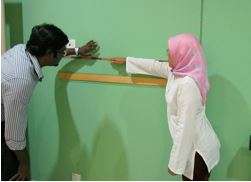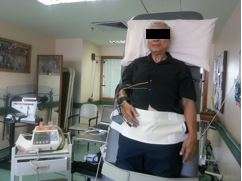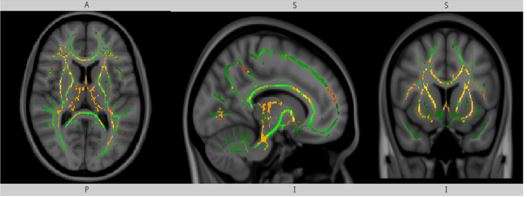Is microstructural integrity of white matter tracts affected in older falling victims?

Researchers from Malaysia assessed the whole brain microstructural integrity of major nerve tracts among older fallers and non-fallers. They proposed the potential synergistic relationship between blood pressure fluctuations with standing, balance disorders and structural brain abnormalities observed among fallers.
Falls are common in the older population. The annual incidence of falls is nearly 30% in individuals 65 years and above and the number is expected to increase further as the population ages. Falls in older people lead to physical disability, psychosocial problems, and deterioration in quality of life and reduced survival. It often results in hospitalization and institutionalization with expensive medical costs.. Falls in the elderly are associated with numerous risk factors, e.g. physical limitation, gait and balance deficits, visual impairment, chronic medical illness, neurological disorders and postural hypotension (a condition linked to a drop in blood pressure withstanding). The study by a group of researchers from University of Malaya recruited older people who had at two falls or one fall with injury over the last 12 months. Their brain image were then compared with similar age people with no history of fall using MRI. A special advanced feature of MRI, Diffusion Tensor Imaging (DTI), was utilized in the study, allowing assessment of the white matter tracts within the brain.
The study assessed the whole brain microstructural integrity of major nerve tracts among the older individuals with a history of falls compared to non-fallers. 85 participants were evaluated clinically and using MRI of the brain [Figure1]. DTI was utilized to study the microstructural integrity of these white matter nerve tracts. Many clinical variables and risk factors known to be related to falls were also collected and analyzed using advanced statistical tests. It was proposed that there is potential synergistic relationship between blood pressure fluctuations with standing, balance disorders and structural brain abnormalities observed among fallers. This is the first study of its kind to utilize DTI for whole brain white tracts analysis while taking into account many contributing factors of fallers in an ageing multi-racial Asian population.

The researchers found several white matter nerve tracts that were significantly different between fallers and non-fallers, and the findings were published in Plos One. Those tracts included the major nerve fibers that connecting the right and left cerebral hemisphere, as well as the cerebral and the lower brain (cerebellum, brainstem and spinal cord). The changes occur in several DTI metrics known as mean diffusivity (MD), axial diffusivity (AD) and radial diffusivity (RD). The researchers' earlier works showed that an AD change not accompanied by FA changes is thought to represent widespread tissue damage, gross tissue loss and increased extracellular space. Tract-based spatial statistics (TBBS) was used to analyze the DTI metrics. TBBS is an advanced computerized technique to overlay the fallers tracts over the normalized non-fallers tracts (known as TBBS skeleton), to highlight the nerve tracts which are significantly different between the two [Figure 2].
Besides the imaging features described above, there were other clinical and imaging variables which demonstrated significant differences between fallers and non-fallers such as the age, clinical parameters for gait and balance (functional-reach and time-up-and-go tests), white matter lesions volume (high signal focus on T2-weighted MRI sequence), hypertension, postural hypotension as well as fainting spells.
Using multivariate statistical analysis, the study showed that only presence of orthostatic hypotension, presence of hypertension, increased white matter lesions volume and decreased in functional-reach distance demonstrated statistical significant differences between fallers and non-fallers. No significant differences were found in the DTI metrics above when taking into account age and the four variables as covariates.

Therefore it was concluded that DTI metrics abnormality is not a singular factor that contributes independently to the fall outcomes. Instead, this novel finding importantly highlights the potentially synergistic effect between blood pressure changes, balance disorders and structural abnormalities of the brain in elderly falls. Nevertheless, the DTI aspect of this study helps to understand further the neurobiology underpinning movement and coordination disturbances in older population with falls. It may also serve as potential biomarkers in future falls intervention trials.
More information: Lord SR (2007) Falls in older people. Risk factors and stategies for prevention. Cambridge University Press, Cambridge United Kingdom
Bloem BR, Steijns JAG, Smits-Engelsman BC (2003) An update on falls. Curr Opin Neurol 16:15–26
Tan MP, Kamaruzzaman SR, Zakaria MI, Chin AV, Poi PJH (2016) Ten-year mortality in older patients attending the emergency department after a fall. Geriatrics & Gerontology International 16(1): p. 111-117.
Englander F, Hodson TJ, Terregrossa RA (1996) Economic dimensions of slip and fall injuries. J Forensic Sci 41:733–746
Axer H, Axer M, Sauer H, Witte OW, Hagemann G (2010) Falls and gait disorders in geriatric neurology. Clin Neurol Neurosurg 112:265–74
Ambrose AF, Paul G, Hausdorff JM (2013) Risk factors for falls among older adults: a review of the literature. Maturitas 75:51–61
Ramli N, Wong YQ, Tan LK, Seow P, Abd Kadir KA, Vijayananthan A and Tan MP (2017) Microstructural integrity of white matter tracts amongst older fallers: A DTI study. PLoS ONE 12 (6): e0179895
Veeramuthu V, Narayanan NV, Tan LK, et al (2015) Diffusion tensor imaging parameters in mild traumatic brain injury and its correlation with early neuropsychological impairment: A longitudinal study. J Neurotrauma 13:1–13
















